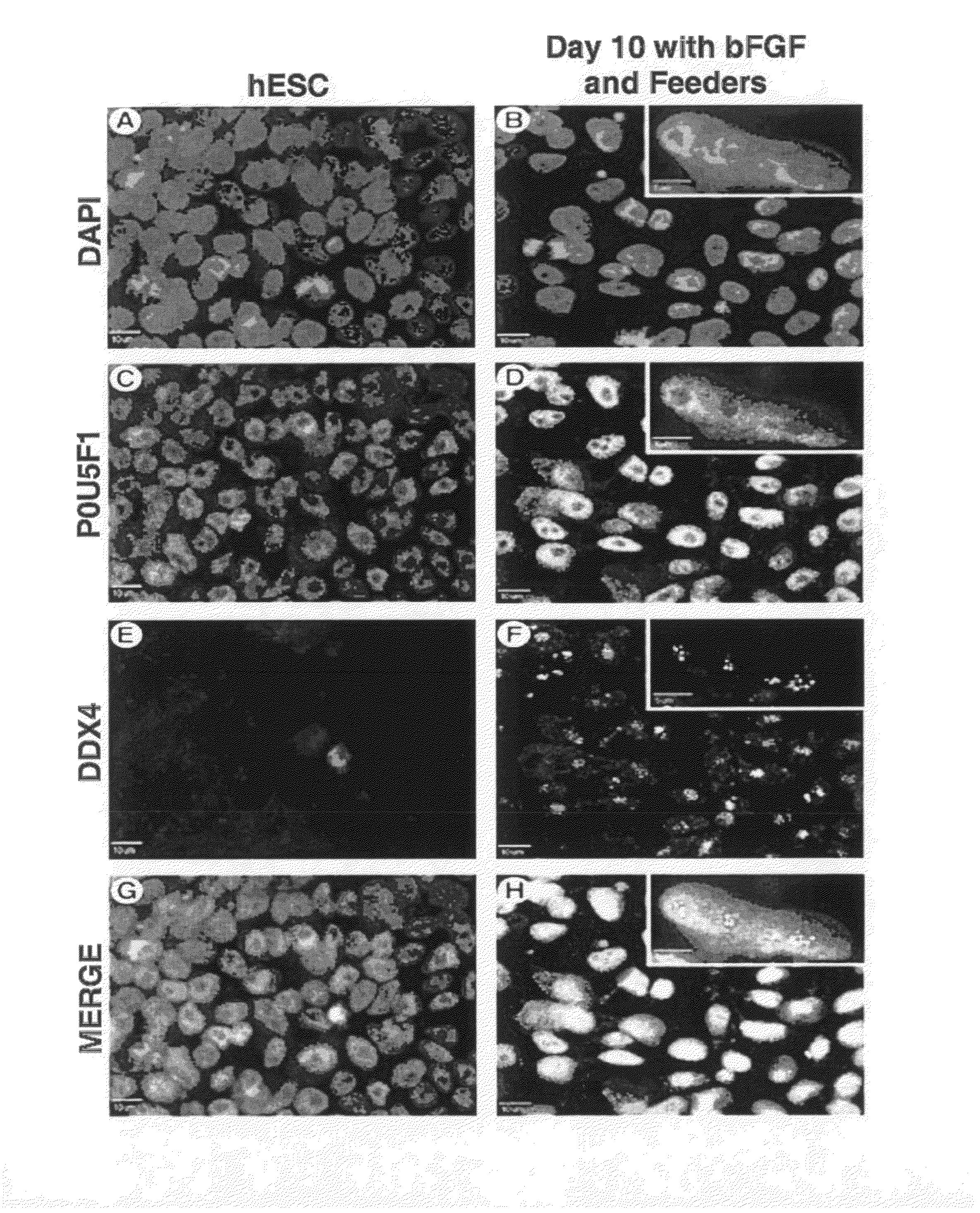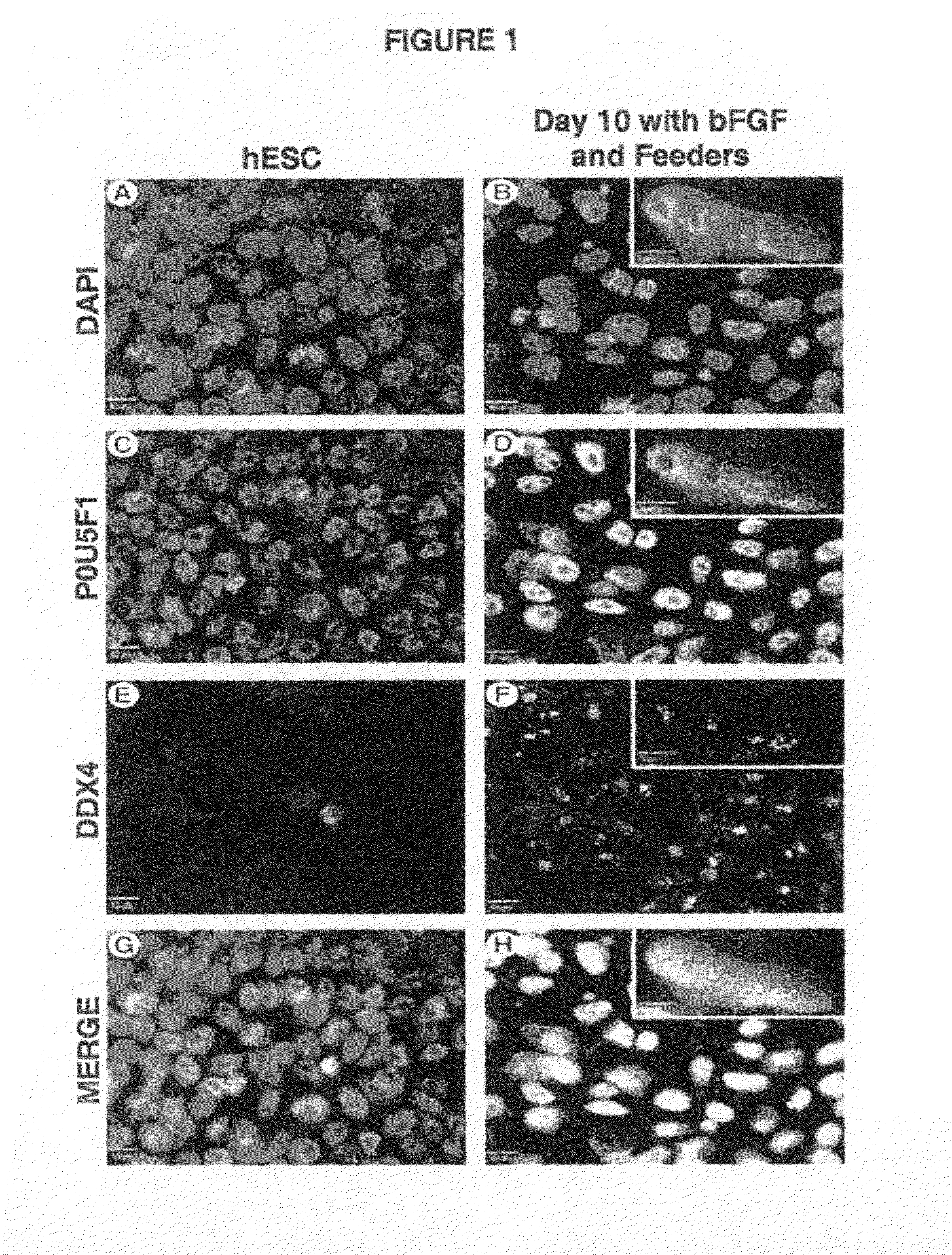Methods of producing germ-like cells and related therapies
a technology of germ-like cells and related therapies, applied in the field of germ-like cell production methods, can solve the problems of ineffective treatment, sterility in both females and males, and the development of assisted reproductive technologies, and achieve the effect of stable karyotype and enhanced glc developmen
- Summary
- Abstract
- Description
- Claims
- Application Information
AI Technical Summary
Benefits of technology
Problems solved by technology
Method used
Image
Examples
example 1
Germ Cell Protein Expression in an Adherent Germ
[0103]DDX4+ POU5F1+ cells were enriched on MEF feeder cocultures and on polyornithine- and laminin-coated plates for 3, 10, and 30 days without passaging under enrichment conditions. Cells grown under enrichment conditions for 3 days with bFGF were under identical hESC maintenance conditions and are considered to be hESC controls. In most cases, 4,6-diamidino-2-phenylindole (DAPI)(FIG. 1A) nuclear staining of hESCs showed colocalization with the pluripotency marker POU5F1 (FIG. 1C) and absence of the germ cell marker DDX4 (FIGS. 1E, 1G, merge). However, after 10 days of differentiation, the pluripotency marker POU5F1 (FIG. 1D) and germ cell marker DDX4 (FIG. 1F) showed nuclear colocalization with DAPI (FIGS. 1B, 1H, merge), with similar results seen at day 30. All treatments showed a subpopulation of DDX4+ POU5F1+ cells, which is indicative of early germ cell development (FIG. 1).
[0104]Unexpectedly, we observed DDX4+...
example 2
Temporal Effect on DDX4+ POU5F1+ Expression
[0105]Immunocytochemistry showed enhanced germ-like marker expression under enrichment conditions; therefore, we used flow cytometry to quantify the enrichment of DDX4+ POU5F1+ cells. Flow analysis further confirmed that a population of cells were indeed positive for both DDX4 and POU5F1 (FIG. 2A). Flow analysis showed that there was a significant (p less than 0.05) temporal effect, with an increase in DDX4+ POU5F1+ cell percentage at day 10 (average of treatments, 57.62±9.20) compared with the ESC control, day 3 (average of treatments, 18.47±1.56), and 30 (average of treatments, 19.62±5.98), with and without feeders and bFGF (FIG. 2B). bFGF played a significant role in increasing the percentage of DDX4+ POU5F1+ cells, but only under feeder-free conditions (FIG. 2B). There was a significant (p less than 0.05) increase in the percentage of DDX4+ POU5F1+ cells at days 10 (34.63%) and 30 (9.16%) in the presence of bFGF. However, bFGF had no si...
example 3
MEF Feeders Increased Germ-Like Gene Expression
Premigratory and Migratory Stage Gene Expression.
[0107]Because of bFGF optimizing the performance of feeder-free cultures by enriching DDX4+ POU5F1+ cells, germ cell gene expression was examined only in the presence of bFGF. Significant increases in premigratory (Ifitm3, DPPA3, POU5F1, and DAZL) and migratory (NANOG and DDX4) germ cell gene expression were observed for cultures both with and without feeders at days 10 and 30; however, cultures grown on feeders consistently showed significantly higher germ cell gene expression than feeder-free conditions, regardless of day (FIG. 3). Cells cultured on feeders had significantly higher POU5F1, DAZL, and NANOG gene expression (p less than 0.05) at both day 10 and day 30, relative to feederless counterparts (fold changes are shown in FIG. 3). Feeder cell-cultured conditions also produced significant (p less than 0.05) increases for DDX4 expression at day 10 and Ifitm3 and DPPA3 expression at ...
PUM
| Property | Measurement | Unit |
|---|---|---|
| concentration | aaaaa | aaaaa |
| temperature | aaaaa | aaaaa |
| concentration | aaaaa | aaaaa |
Abstract
Description
Claims
Application Information
 Login to View More
Login to View More - R&D
- Intellectual Property
- Life Sciences
- Materials
- Tech Scout
- Unparalleled Data Quality
- Higher Quality Content
- 60% Fewer Hallucinations
Browse by: Latest US Patents, China's latest patents, Technical Efficacy Thesaurus, Application Domain, Technology Topic, Popular Technical Reports.
© 2025 PatSnap. All rights reserved.Legal|Privacy policy|Modern Slavery Act Transparency Statement|Sitemap|About US| Contact US: help@patsnap.com



